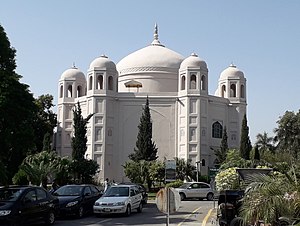The Tomb of Anarkali (Urdu: مقبره انارکلی) is an octagonal 16th century Mughal monument in Lahore, capital of the Pakistani province of Punjab.
مقبرہ انارکلی | |
 | |
 | |
| 31°34′03″N 74°18′02″E / 31.56750°N 74.30056°E | |
| Location | Lahore, Punjab, Pakistan |
|---|---|
| Type | Mausoleum |
| Material | brick |
| Completion date | 1599, or 1615 |
| Dedicated to | Anarkali |
Location
editThe tomb of Anarkali is located on the grounds of Lahore's Punjab Civil Secretariat complex near the British-era Mall, southwest of the Walled City of Lahore. It is considered to be one of the earliest Mughal tombs still in existence, and is considered to be one of the most significant buildings of the early Mughal period.[1][2] The building is currently used as the Punjab Archives, and public access is limited.[2]
History
editConstruction of the tomb dates to either 1599, or 1615.[3]
The tomb was said to be built by the Mughal Emperor Jehangir for his love, named in contemporary travel accounts as Anarkali, who, as per legend, was suspected by Emperor Akbar to have relations with Jehangir, at the time known as Prince Saleem. [3] There is no other historic proof of Anarakali's existence than that of Jahangir's contemporary western traveler's accounts which could not be independently confirmed; the rest is some scholarly speculated hypothesis and/ or subsequent literary fictionalization of her character which often appears in movies, books and fictionalized versions of history.
During the time of the Sikh Empire, the tomb was occupied by Kharak Singh,[4] and later was further desecrated by its conversion into the residence for the wife of General Jean-Baptiste Ventura, who was employed in the army of Ranjit Singh.[1] The tomb was then converted during the British Raj into clerical offices in 1847 before being turned into the Anglican St. James Church in 1851, and later regarded as Lahore's "Protestant Cathedral."[5] In 1891, the church congregation was relocated, and the tomb was repurposed as the Punjab Record Office.[1]
The occupant's cenotaph was removed when the tomb was repurposed into a church. When the building no longer served as a church, the cenotaph was placed at the site of the former altar, and not at the original site of the cenotaph.[1]
Architecture
editThe structure's foundations are in the basic shape of an octagon, with alternating measurements of 44 feet and 30 feet for each side with semi-octagonal towers at each corner. The structure is also topped by a double-dome, and is one of the earlier examples of such a dome from the Mughal era. The dome rests upon 8 arches, each measuring 12 feet 3 inches.[1]
The large arches in the sides of the building were once open in typical Mughal fashion, but were blocked off by the British.[4]
The building is today covered in whitewashing. It was reportedly once surrounded by a garden.[4] The building is currently used as the Punjab Archives, so access to the public is limited.[1]
Cenotaph
editThe white marble cenotaph features carvings with the 99 names of Allah, and was described by 19th-century historians as "one of the finest pieces of carving in the world."[6]
- Inscription
In addition to the 99 names of Allah, the cenotaph is inscribed with a Persian couplet taken from the Persian poet Saadi[7] which reads:
- آه گر من بازبینم روی یار خویش را
- تا قیامت شکر گویم کردگار خویش را
- Ah gar man baz binam ruyi yari khwish ra
- Ta qayamat shukr goyam kardgari khwish ra
- "Ah! could I behold the face of my beloved once more,
- I would give thanks unto my Creator until the day of resurrection"
Conservation
editThe tomb is listed on the Protected Heritage Monuments of the Archaeology Department of Punjab.[8]
In Popular Culture
editThe Anarkali Tomb was portrayed in Shoaib Mansoor's song "Supreme Ishq" as a shooting location of Anarkali.
Notes
editReferences
edit- ^ a b c d e f "Anarkali's Tomb". Lahore Sites. Archived from the original on 25 August 2016. Retrieved 23 August 2016.
- ^ a b Khalid, Haroon (17 August 2018). "Humble Origins (First 3 pages of Chapter 8)". Imagining Lahore : the city that is, the city that was. India: Penguin Random House India Private Limited. ISBN 978-93-5305-199-0. OCLC 1051299628.
- ^ a b "Legend: Anarkali: myth, mystery and history". Dawn. 11 February 2012. Retrieved 23 August 2016.
- ^ a b c "Anarkali's Tomb". Asian Historical Architecture. Retrieved 24 August 2016.
- ^ Glover, William (January 2007). Making Lahore Modern, Constructing and Imagining a Colonial City. Univ Of Minnesota Press. ISBN 978-0816650224.
What is more striking than the fact that the Punjab's new rulers (cost-effectively) appropriated the symbolically charged buildings of their predecessors is how long some of those appropriations lasted. The conversion of the Mughal-era tomb of Sharif un-Nissa, a noblewoman during Shah Jahan's reign, popularly known as Anarkali, was one such case (Figure 1.2). This Muslim tomb was first used as offices and residences for the clerical staff of Punjab's governing board. In 1851, however, the tomb was converted into the Anglican church
- ^ Eastwick, Edward Backhouse (1883). Handbook of the Punjab, Western Rajputana, Kashmir, and Upper Sindh. London: John Murray, Albemarle Street.
- ^ Saadi ghazal 31 line 1
- ^ Pakistan Environmental Protection Agency. "Guidelines for Critical and Sensitive Areas" (PDF). Government of Pakistan. pp. 12, 47, 48. Archived from the original (PDF) on 14 October 2013. Retrieved 6 June 2013.